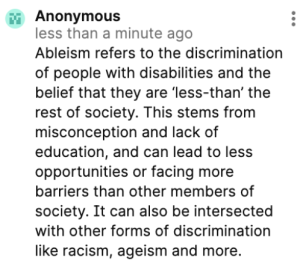6
Section one: The fundamentals
A)
Exercise 1: Notebook Prompt
Many of you are likely familiar with the concept of “ability inequity,” which the authors of this article define as “an unjust or unfair (a) ‘distribution of access to and protection from abilities generated through human interventions’ or (b) ‘judgment of abilities intrinsic to biological structures such as the human body’.”
However, they go on to identify the following “ability concepts” that are less familiar:
1) ability security (one is able to live a decent life with whatever set of abilities one has)
2) ability identity security (to be able to be at ease with ones abilities)
How prevalent are these forms of security among disabled people you know? Or, if you identify as a disabled person, would you say your social surroundings and community foster and support these kinds of security? Furthermore, while the focus of the article is on Kinesiology programs, it is also important to reflect on how academia in general accommodates for disability. If you feel comfortable answering this question, what has been your experience of postsecondary education to date?
-OR-
The authors also observe that “Ableism not only intersects with other forms of oppression, such as racism, sexism, ageism, and classism, but abilities are often used to justify such negative ‘isms’.”
What do you think this means? Provide an example.
| “Ableism not only intersects with other forms of oppression, such as racism, sexism, ageism, and classism, but abilities are often used to justify such negative ‘isms’.” This means that people sometimes use people’s abilities to justify discrimination in other characteristics of people like gender, race, age and more. An example could include the treatment of a patient who is female and disabled in the hospital. On top of the negative views nurses may have of the patient because of the disability, the fact that she is female may further contribute to the view that they may be valued more as a male, or the stereotypes of how females ‘are dramatic’ and ‘not actually in need of care’. |
Exercise 2: Implicit Bias Test
Did anything surprise you about the results of the test? Please share if you’re comfortable OR comment on the usefulness of these kinds of tests more generally.
| My results surprised me and how quick I was answering questions when I could match positive words to abled people and negative words to disabled people. I’ve always known people have unconscious biases but my when my results came back it surprised me. |
B) Keywords
Exercise 3:
Add the keyword you contributed to padlet and briefly (50 words max) explain its importance to you.
| Ableism refers to the discrimination of people with disabilities and the belief that they are ‘less-than’ the rest of society. This stems from misconception and lack of education, and can lead to less opportunities or facing more barriers than other members of society. It can also be intersected with other forms of discrimination like racism, ageism and more. |
B) On Disability
Exercise 4: Complete the Activities

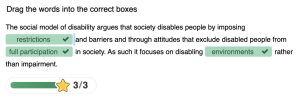

Exercise 5: Notebook Prompt
What do Fitzgerald and Long identify as barriers to inclusion and how might these apply to sport in particular?
Barriers to inclusion are associated with the negative views placed on people with disabilities. The medical model describes how people see what they cannot do over what they can do and are focused on ‘fixing’ them to society’s version of ‘normalcy’. In sports, this allows people to assume people are not capable of participating in activities and are therefore excluded or given special assistance. The social model describes how restrictions and barriers are placed on those with disabilities because of the attitudes of others. In sports, this talks about restricting resources, programs and staff.
C) Inclusion, Integration, Separation
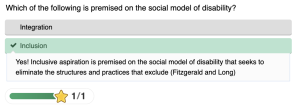
Exercise 6: Complete the Activities
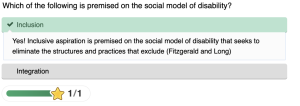
Exercise 7: Notebook Prompt
Choose ONE of the three questions Fitzgerald and Long argue disability sport needs to address and record your thoughts in your Notebook.
- Should sport be grouped by ability or disability?
- Is sport for participation or competition?
- Should sport competitions be integrated?
| Should sport be grouped by ability or disability? Sport should be grouped by ability, therefore setting a new society ‘norm’ and focusing on different aspects like improving skills. This takes away the idea that sport in general is something that people who are disabled should be excluded from. |
Part Two: Making Connections
A) Gender, Sport and Disability
Exercise 8: Complete the Activity
The paradox that sportswomen habitually face (as the authors observe, this isn’t confined to disabled sportswomen) involves the expectation they will be successful in a ‘masculine’ environment while complying with femininity norms in order to be recognized as a woman.
True or false?
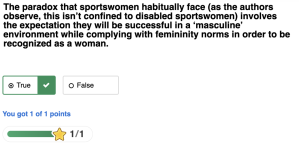
Take a moment to reflect on this paradox below (optional).
B) Masculinity, Disability, and Murderball
Exercise 9: Notebook/Padlet Prompt
Watch the film, Murderball and respond to the question in the padlet below (you will have an opportunity to return to the film at the end of this module).
The authors of “Cripping Sport and Physical Activity: An Intersectional Approach to Gender and Disability” observe that the “gendered performance of the wheelchair rugby players can…be interpreted as a form of resistance to marginalized masculinity” (332) but also point out that it may reinforce “ableist norms of masculinity.” After viewing the film, which argument do you agree with?
a) Murderball celebrates a kind of resistance to marginalized masculinity

| I think murderball does both of these things. I think it can be interpreted as a form of resistance to marginalized masculinity because the film focuses on showing the athletes as strong and capable and fighting against the view of being weak or in need of special assistance. I also think it may reinforce “ableist norms of masculinity” because the players are aggressive and dominant, just as regular masculinity is seen as. |
Section Three: Taking a Shot
A) Resistance
B) Calling out Supercrip
Exercise 10: Mini Assignment (worth 5% in addition to the module grade)
1) Do you agree with the critique of the “supercrip” narrative in this video? Why or why not? Find an example of the “supercrip” Paralympian in the 2024 Paris Paralympics or Special Olympics coverage and explain how it works.
| I think the video is promoting motivation and a positive view on disabled athletes, but I think the target audience is also for those who are not disabled to promote things like funding for those who cannot participate in the actual olympics. I think the viewpoint is from the perspective of the average anatomical body because it displays the special olympics while pointing out that they are in fact different, as mentioned in the critique (Bell, 2023). I think the critique becomes more credible also because it is written from the perspective of a disabled person, and they would understand the lived experience of a disabled athlete more than anyone. Supercrip narratives are also difficult to understand because they are promoted for short periods of time so it is more useful as awareness (Barnes, 2023). They seem to be presented in a simple way and lack the explanation of the whole story and all the struggles included. For example, Jessica Smith, a Para-swimmer, talks about how she had to learn to adapt and be creative to work around the barriers she faced (Barnes, 2023). In addition, Louise Fiddes, another para-swimmer, talks about how she had to work a lot harder in life for the same things regular people can easily do, creating a habit to work hard at everything she did (Barnes, 2023). These are things not mentioned in the paralympic advertisements.
References Barnes, C. (2023, March 28). Redefining inspiration: The evolving narrative of Paralympic athletes. Crip Life. https://criplife.co.uk/redefining-inspiration-the-evolving-narrative-of-paralympic-athletes/ Bell, R. (2023, April 3). Grappling with ableism in the para-sport movement. Rooted in Rights. https://rootedinrights.org/grappling-with-ableism-in-the-para-sport-movement/
|
2) Does the film Murderball play into the supercrip narrative in your opinion? How does gender inform supercrip (read this blog for some ideas)?
(300 words for each response)
| Murderball plays into supercrip narratives because of the positive representation of people with disabilities playing sports. It portrays disability as something you need to beat to be strong and capable to play sports. It demonstrates how masculinity is achieved through overcoming the disability and staying strong in a world created from a different societal view. This is not necessarily true. Women are portrayed differently in murderball. They are seen as more vulnerable or independent than competitive and tough as the guys seem. People who are disabled are usually seen in a positive light after accomplishing extraordinary things (Mattlin, 2022). Our society views people who are disabled as happy only when they work extra hard to fit in with our cultural norms. They are seen as inspirations only after accomplishing things people without disabilities do not. Murderball plays into the idea that people with disabilities are superheros, when they are actually just regular people trying to play sports in a world that does not allow them to.
References Mattlin, B. (2022). I am not your supercrip. Facing Disability. https://facingdisability.com/blog/i-am-not-your-supercrip
|

